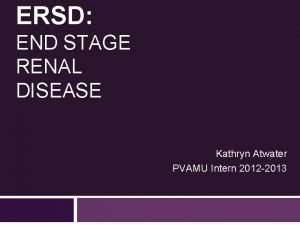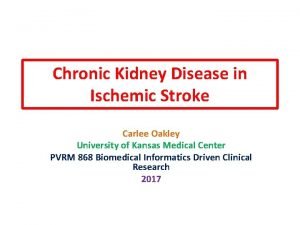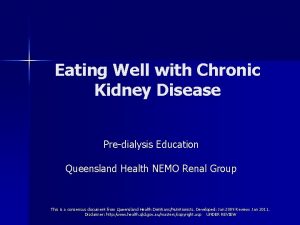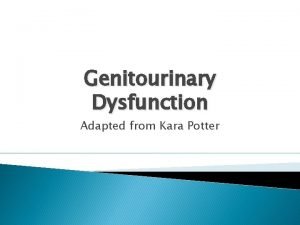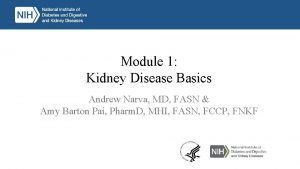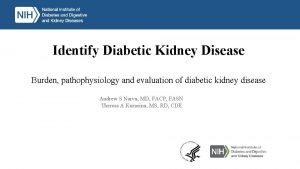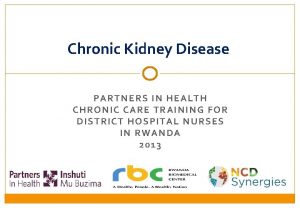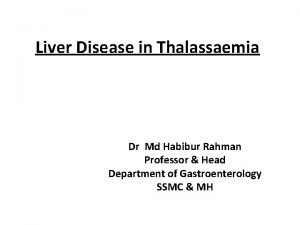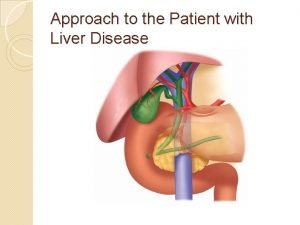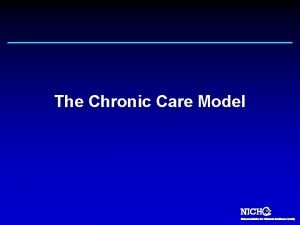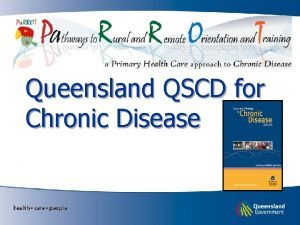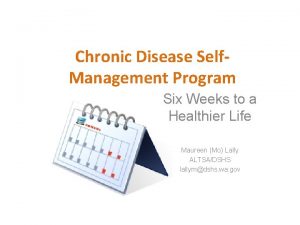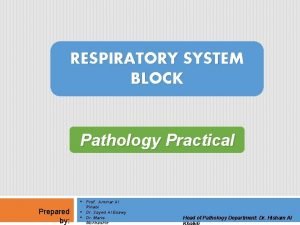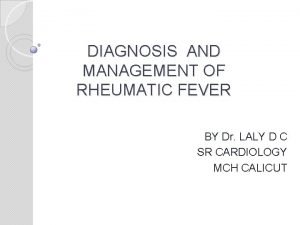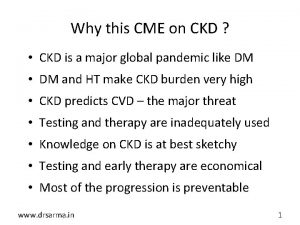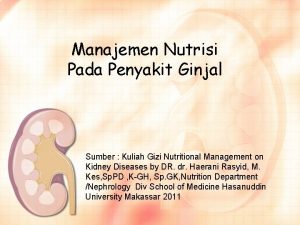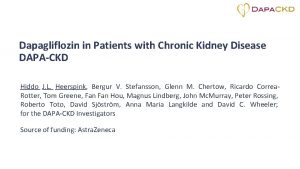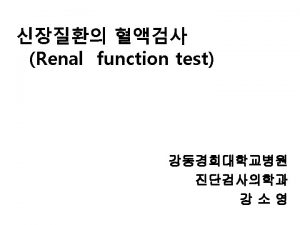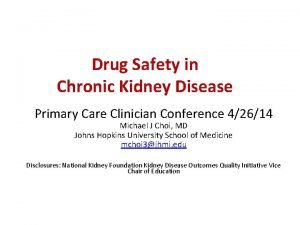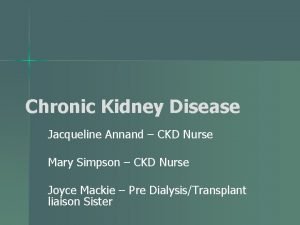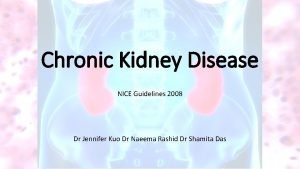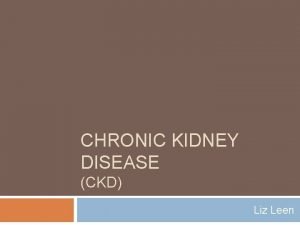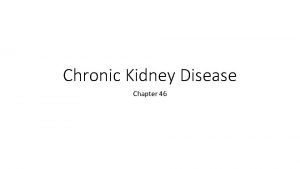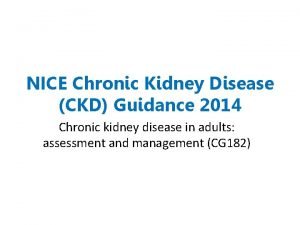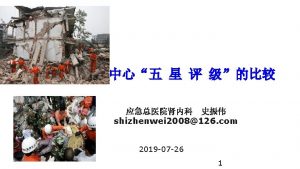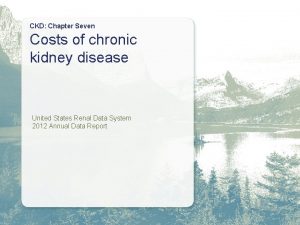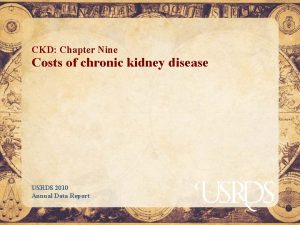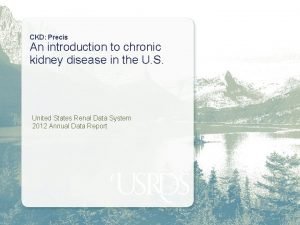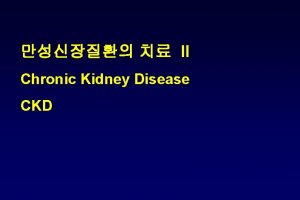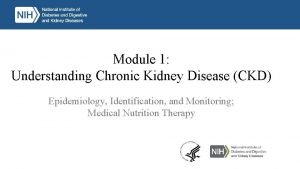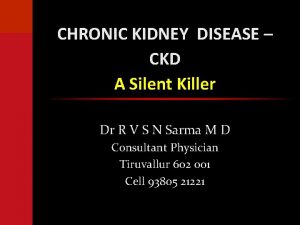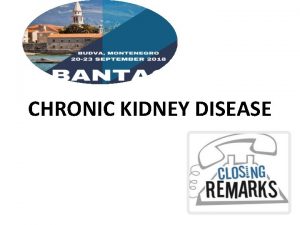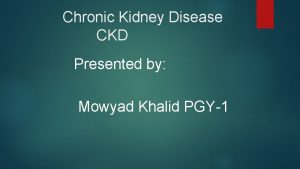CKD Chapter Two Chronic kidney disease identified in






























- Slides: 30

CKD: Chapter Two Chronic kidney disease identified in the claims data USRDS 2010 Annual Data Report

Distribution of period prevalent general Medicare (age 65+) & Market. Scan (age 50– 64) patients with diagnosed CKD, CHF, cancer, & diabetes, 2008 Figure 2. 1 (Volume 1) Point prevalent general (fee-for-service) Medicare patients age 65 & older; point prevalent Market. Scan patients age 50– 64. CKD, CHF, cancer, & diabetes determined from claims. USRDS 2010 ADR

Descriptive parameters of CKD datasets, by age, gender, race, ethnicity, comorbidity, & occupation, 2008 Table 2. a (Volume 1) Prevalent patients surviving 2008, without ESRD, age 65 & older (Medicare) & 20– 64 (Market. Scan & Ingenix i 3). USRDS 2010 ADR

Incidence of recognized CKD, by U. S. Census Region & dataset, 2008 Figure 2. 2 (Volume 1) Prevalent patients surviving 2008, without CKD in 2007 & without ESRD, age 65 & older (Medicare) & 20– 64 (Market. Scan & Ingenix i 3). USRDS 2010 ADR

Prevalence of recognized CKD, by U. S. Census Region & dataset, 2008 Figure 2. 3 (Volume 1) Prevalent patients surviving 2008, without ESRD, age 65 & older (Medicare) & 20– 64 (Market. Scan & Ingenix i 3). USRDS 2010 ADR

Incidence of recognized CKD, by year & dataset Figure 2. 4 (Volume 1) Prevalent patients surviving cohort year, without CKD in prior year & without ESRD, age 65 & older (Medicare) & 20– 64 (Market. Scan & Ingenix i 3). USRDS 2010 ADR

Incidence of recognized CKD, by age & dataset, 2008 Figure 2. 5 (Volume 1) Prevalent patients surviving cohort year, without CKD in prior year & without ESRD, age 65 & older (Medicare) & 20– 64 (Market. Scan & Ingenix i 3). USRDS 2010 ADR

Incidence of recognized CKD, by gender & dataset, 2008 Figure 2. 6 (Volume 1) Prevalent patients surviving cohort year, without CKD in prior year & without ESRD, age 65 & older (Medicare) & 20– 64 (Market. Scan & Ingenix i 3). USRDS 2010 ADR

Prevalence of recognized CKD, by year & dataset, 2008 Figure 2. 7 (Volume 1) Prevalent patients surviving cohort year, without ESRD, age 65 & older (Medicare) & 20– 64 (Market. Scan & Ingenix i 3). USRDS 2010 ADR

Prevalence of recognized CKD, by age & dataset, 2008 Figure 2. 8 (Volume 1) Prevalent patients surviving cohort year, without ESRD, age 65 & older (Medicare) & 20– 64 (Market. Scan & Ingenix i 3). USRDS 2010 ADR

Prevalence of recognized CKD, by gender & dataset, 2008 Figure 2. 9 (Volume 1) Prevalent patients surviving cohort year, without ESRD, age 65 & older (Medicare) & 20– 64 (Market. Scan & Ingenix i 3). USRDS 2010 ADR

Stages of incident CKD as defined by the new diagnosis codes: Medicare patients age 65 & older, by race Figure 2. 10 (Volume 1) Prevalent patients surviving cohort year, without CKD in prior year & without ESRD, age 65 & older (Medicare) & 20– 64 (Market. Scan & Ingenix i 3). USRDS 2010 ADR

Trends in CKD incidence: Medicare patients age 65 & older, by race Figure 2. 11 (Volume 1) Prevalent patients surviving cohort year, without CKD in prior year & without ESRD, age 65 & older (Medicare) & 20– 64 (Market. Scan & Ingenix i 3). USRDS 2010 ADR

Stages of incident CKD as defined by the new diagnosis codes: Market. Scan patients age 20– 64 Figure 2. 12 (Volume 1) Prevalent patients surviving cohort year, without CKD in prior year & without ESRD, age 65 & older (Medicare) & 20– 64 (Market. Scan & Ingenix i 3). USRDS 2010 ADR

Stages of incident CKD as defined by the new diagnosis codes: Ingenix i 3 patients age 20– 64 Figure 2. 13 (Volume 1) Prevalent patients surviving cohort year, without CKD in prior year & without ESRD, age 65 & older (Medicare) & 20– 64 (Market. Scan & Ingenix i 3). USRDS 2010 ADR

Stages of prevalent CKD as defined by the new diagnosis codes: Medicare patients age 65 & older, by race Figure 2. 14 (Volume 1) Prevalent patients surviving cohort year, without ESRD, age 65 & older (Medicare) & 20– 64 (Market. Scan & Ingenix i 3). USRDS 2010 ADR

Trends in CKD prevalence: Medicare patients age 65 & older, by race Figure 2. 15 (Volume 1) Prevalent patients surviving cohort year, without ESRD, age 65 & older (Medicare) & 20– 64 (Market. Scan & Ingenix i 3). USRDS 2010 ADR

Stages of prevalent CKD as defined by the new diagnosis codes: Market. Scan patients age 20– 64 Figure 2. 16 (Volume 1) Prevalent patients surviving cohort year, without ESRD, age 65 & older (Medicare) & 20– 64 (Market. Scan & Ingenix i 3). USRDS 2010 ADR

Stages of prevalent CKD as defined by the new diagnosis codes: Ingenix i 3 patients age 20– 64 Figure 2. 17 (Volume 1) Prevalent patients surviving cohort year, without ESRD, age 65 & older (Medicare) & 20– 64 (Market. Scan & Ingenix i 3). USRDS 2010 ADR

Comorbidity in the recognized CKD population, by CKD diagnosis code & race (percent), 2008 Table 2. b (Volume 1) Medicare patients age 65 & older, surviving all of 2008; ESRD patients excluded. USRDS 2010 ADR

Prevalence of diabetes, by diagnosis code, race, & year Table 2. 18 (Volume 1) Medicare patients age 65 & older, surviving all of 2008; ESRD patients excluded. USRDS 2010 ADR

Prevalence of hypertension, by diagnosis code, race, & year Table 2. 19 (Volume 1) Medicare patients age 65 & older, surviving all of 2008; ESRD patients excluded. USRDS 2010 ADR

Comorbidity in the non-CKD & recognized CKD populations, by GFR estimation method: Ingenix i 3 patients, 2008 Table 2. c (Volume 1) *Claims-based comorbidities. **Defined from laboratory values. Elevated uric acid defined as ≥ 7 mg/dl for males & ≥ 6 mg/dl for females. Abnormality of uric acid & parathyroid hormone defined by ≥ 95 th percentile, NHANES data. Abnormality of calcium defined by ≤ 5 th percentile, NHANES data. Abnormality of glucose based on normal range, Ingenix i 3 data. WHO anemia defined as hemoglobin <13 g/dl in males, <12 g/dl in females. Elevated triglycerides ≥ 150 mg/dl; reduced HDL (“good”) cholesterol: males <40 mg/dl; females <50 mg/dl; based on criteria proposed by the National Cholesterol Education Program (NCEP) Adult Treatment Panel III (ATP III). Prevalent Ingenix i 3 patients age 20– 64, surviving all of 2008; ESRD patients excluded. USRDS 2010 ADR

e. GFR, by CKD diagnosis code & GFR estimation method: Ingenix i 3 patients, 2008 Figure 2. 20 (Volume 1) Prevalent Ingenix i 3 patients age 20– 64, 2008; error bars represent the 25 th & 75 th percentiles. ESRD patients excluded. USRDS 2010 ADR

Patients with elevated uric acid levels, by CKD stage & GFR estimation method, 2008 Figure 2. 21 (Volume 1) Prevalent Ingenix i 3 patients age 20– 64, 2008; ESRD patients excluded. See footnote to Table 2. c for definitions. USRDS 2010 ADR

Patients with below-normal calcium levels, by CKD stage & GFR estimation method, 2008 Figure 2. 22 (Volume 1) Prevalent Ingenix i 3 patients age 20– 64, 2008; ESRD patients excluded. See footnote to Table 2. c for definitions. USRDS 2010 ADR

Patients with elevated PTH levels, by CKD stage & GFR estimation method, 2008 Figure 2. 23 (Volume 1) Prevalent Ingenix i 3 patients age 20– 64, 2008; ESRD patients excluded. See footnote to Table 2. c for definitions. USRDS 2010 ADR

Patients with HDL levels below guidelines, by CKD stage & GFR estimation method, 2008 Figure 2. 24 (Volume 1) Prevalent Ingenix i 3 patients age 20– 64, 2008; ESRD patients excluded. See footnote to Table 2. c for definitions. USRDS 2010 ADR

Patients with elevated triglyceride levels, by CKD stage & GFR estimation method, 2008 Figure 2. 25 (Volume 1) Prevalent Ingenix i 3 patients age 20– 64, 2008; ESRD patients excluded. See footnote to Table 2. c for definitions. USRDS 2010 ADR

Patients with fasting glucose levels > normal, by CKD stage & GFR estimation method, 2008 Figure 2. 26 (Volume 1) Prevalent Ingenix i 3 patients age 20– 64, 2008; ESRD patients excluded. See footnote to Table 2. c for definitions. USRDS 2010 ADR
 Chronic kidney disease near atwater
Chronic kidney disease near atwater Nih score
Nih score Nemo ckd
Nemo ckd Sighns of kidney problems
Sighns of kidney problems Natremia
Natremia Albumin kidney disease
Albumin kidney disease Albumin kidney disease
Albumin kidney disease Symptomatic polycystic kidney disease
Symptomatic polycystic kidney disease Chronic granulomatous disease
Chronic granulomatous disease Stigmata of chronic liver disease
Stigmata of chronic liver disease Jewish chronic disease study
Jewish chronic disease study Difference between cld and dcld
Difference between cld and dcld Stigmata of chronic liver disease
Stigmata of chronic liver disease Nonalcoholic fatty liver disease
Nonalcoholic fatty liver disease Kate lorig chronic disease self-management
Kate lorig chronic disease self-management Ed wagner chronic care model
Ed wagner chronic care model Chronic disease
Chronic disease Is cirrhosis treatable
Is cirrhosis treatable Chronic disease
Chronic disease Dohányos tüdő
Dohányos tüdő Chronic rheumatic heart disease
Chronic rheumatic heart disease Cme ckd
Cme ckd Autoimmune diet
Autoimmune diet Dapa ckd slides
Dapa ckd slides Ace inhibitors in ckd
Ace inhibitors in ckd Ckd epi equation formula
Ckd epi equation formula Gfr hesaplama 140-yaş
Gfr hesaplama 140-yaş Glitol
Glitol Ckd stagea
Ckd stagea Nice ckd
Nice ckd Ckd pes statements
Ckd pes statements
